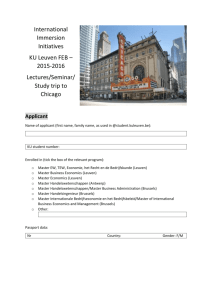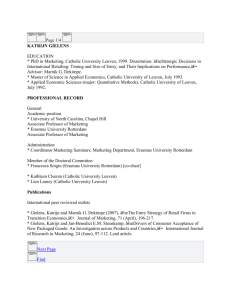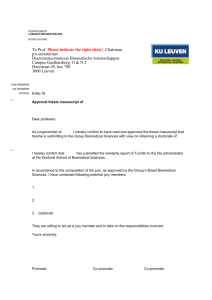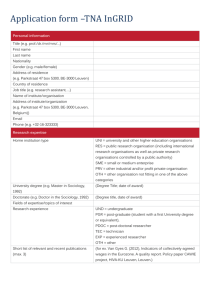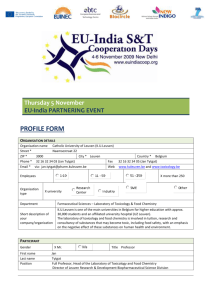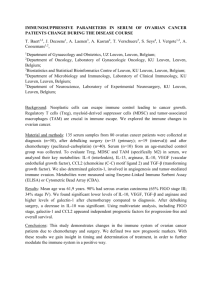Foreign Policy - FEB
advertisement
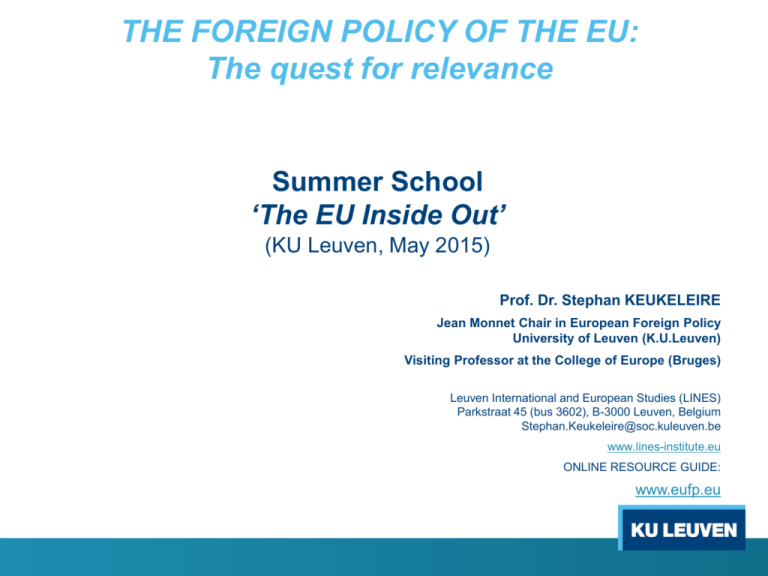
THE FOREIGN POLICY OF THE EU: The quest for relevance Summer School ‘The EU Inside Out’ (KU Leuven, May 2015) Prof. Dr. Stephan KEUKELEIRE Jean Monnet Chair in European Foreign Policy University of Leuven (K.U.Leuven) Visiting Professor at the College of Europe (Bruges) Leuven International and European Studies (LINES) Parkstraat 45 (bus 3602), B-3000 Leuven, Belgium Stephan.Keukeleire@soc.kuleuven.be www.lines-institute.eu ONLINE RESOURCE GUIDE: www.eufp.eu The creation of CFSP (Maastricht Treaty, 1991/1993): a deconstruction The creation of CFSP (Maastricht Treaty, 1991/1993): a deconstruction The Nature of EUFP (1) • Multi-faceted o o o o o Common Foreign & Security Policy (CFSP) Common Security and Defence Policy (CSDP) ‘External action’ (Development, trade, …) External dimensions of internal policies Interaction with member state foreign policies EUFP neither exclusive nor all-encompassing The Nature of EU Foreign Policy (2) • Multi-method o o o Intergovernmental method (CFSP, CSDP) Community method (External action, …) National method • Multi-level & Multi-location o o o Interaction between national and EU levels Interaction between EUFP and other IO zero-sum vs. positive-sum game CSDP: current military operations and civilian missions Relational foreign policy versus Structural foreign policy • Relation foreign policy • Structural foreign policy = a foreign policy which, conducted over the long-term, seeks to influence or shape sustainable political, legal, socio-economic, security and mental structures on the various relevant levels (individuals, societies, states, regional and international level). = about the games and rules of the game that determine behavior of actors © Prof. Keukeleire, University of Leuven www.exploringeurope.eu/foreignpolicy Structural Foreign Policy (SFP) © Keukeleire and Deleux, 2014 The Foreign Policy of the EU Structural foreign policy - Examples Examples of the SFP of the EU EC/EU policy vis-à-vis CEEC since 1988 Policy towards the Palestinian Territories after 1995 Stability Pact for South-Eastern Europe (Balkans) Policy towards Kosovo European Mediterranean Policy (EMP) European Neighbourhood Policy (ENP) Competing structural powers and structural foreign policies American policy Russian policy towards the CIS ‘Islamism’: Salafism/Wahabism; IS; Saudi Arabia; Qatar; Iran; Turkey(?); … China … © Prof. Keukeleire, University of Leuven www.exploringeurope.eu/foreignpolicy Overcoming European/Western navel-gazing The search for relevance • Global level • Regional level • Societal and individual level The search for relevant knowledge 10 Regional level 11 Societal and individual level “Please tell me if you have a very favorable, somewhat favorable, somewhat unfavorable or very unfavorable opinion of the EU?” Percentage of respondents replying ‘very favorable’ or ‘somewhat favorable’ 2012 2010 Japan 65 73 Russia 59 69 Tunisia 58 -- Lebanon 54 61 United States 50 57 Brazil 44 55 Egypt 39 42 Mexico 37 42 China 33 47 Jordan 25 29 Turkey 21 28 India 21 -- Pakistan 13 8 Source: Pew Research Centre Global Attitudes Project (2013) © Keukeleire and MacNaughtan, The The BRICS and other new constellations of power © Keukeleire and MacNaughtan, The Foreign Policy of the EU III. Need to think outside the (European) box and to adopt an outside-in perspective • Geographic outside-in approach • Disciplinary outside-in approach • Impact-based outside–in approach Implications for the EEAS Implications for the academic world 欧洲联盟 18 Внешняя политика 19 الدولة اإلسالمية في العراق والشام 20 Towards an Outside-in approach in assessing the EU’s role in the world © Keukeleire and MacNaughtan, The © Keukeleire and MacNaughtan, Policy of the EU The Foreign EU foreign policy & the (new?) institutional set-up: Fit for purpose? o o o o No single European foreign policy! The remaining important role of the member states (and large member states in particular) The new composition and organization of the European Commission (and EEAS?) The new leaders: Tusk, Juncker, Mogherini, and the various new Commissioners BUT: will the new organisational setup enable the EU o to increase the EU’s relevance? o and to diminish the EU’s knowledge gap? 26 © Keukeleire and MacNaughtan, The Recent Publications Keukeleire, S. and Delreux, T. (2014) The Foreign Policy of the European Union. 2nd Edition (Basingstoke: Palgrave Macmillan, 390 pp.). • Keukeleire S. and Delreux, T. (2015) ‘Competing structural powers and challenges for the EU’s structural foreign policy’, Global Affairs, 1(1), pp. 43-50. http://www.tandfonline.com/doi/pdf/10.1080/23340460.2015.983730http://www.tandfonline.com/doi/pdf/1 0.1080/23340460.2015.983730 Keukeleire, S. and Hooijmaaijers, B. (2014) ‘The BRICS and other Emerging Power Alliances and Multilateral Organisations in the Asia-Pacific and the Global South: Challenges for the European Union and its View on Multilateralism’, Journal of Common Market Studies, 52(3), pp. 582-599. http://onlinelibrary.wiley.com/doi/10.1111/jcms.12102/abstract Keukeleire, S. (2014) ‘Lessons for the Practice and Analysis of EU Diplomacy from an “Outside-in” Perspective’, in Gstöhl, S. and Lannon, E. (eds.), The Neighbours of the EU’s Neighbours: Diplomatic and Geopolitical Dimensions beyond the ENP, Ashgate, pp. 227-241. Keukeleire, S. and Raube, K. (2013) ‘The Security-Development Nexus and Securitisation in the EU’s policies towards developing countries’, in Cambridge Review of International Relations, 26(4). http://www.tandfonline.com/doi/abs/10.1080/09557571.2013.822851#.U-ojVE2KDcu ONLINE RESOURCE GUIDE: www.eufp.eu www.eufp.eu


